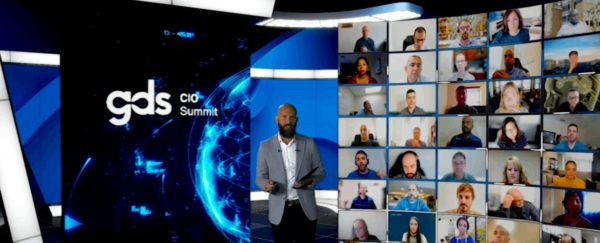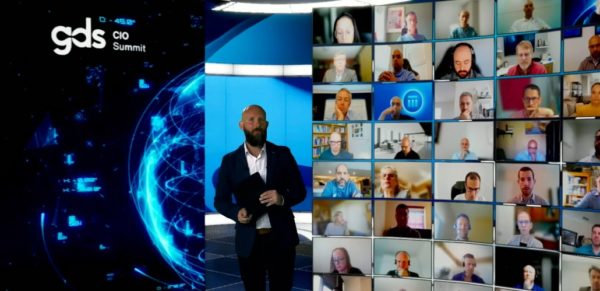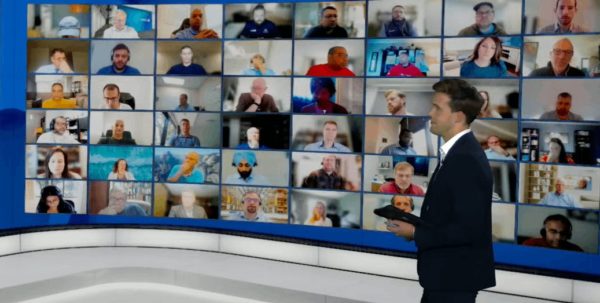“Run like a tech company, think like a people company.” Angelic Gibson, CIO, AvidXchange
Thanks to the often depersonalizing influence of modern innovation, many of have become increasingly socially distant. We spend more time on our phones than ever before and social technologies have actually made us less amiable. It’s incredibly rare then, that each of us gets to share a similar experience at the international level. However, as March of 2020 demonstrated, in some circumstances, this isn’t always a bad thing.
If big business has learned anything from the pandemic, it’s that compassion and empathy are critical to organizational success. In the intervening years, hybrid work has entered the norm and our relationship with work has shifted irrevocably. As a result, the workplace and the workforce are shifting, but with them, so too are CIOs. More and more, the Chief Information Officer has to consider not only technological concerns but also those pertaining to HR.
In 2022, at least 84% of top CIOs will have responsibility for areas of the business outside of traditional IT. With this in mind, we need to cultivate CIOs that work for their people as well as for innovation. In short, we need a hybrid CIO, one that is able to move between IT and HR responsibilities seamlessly. This became abundantly clear at GDS’ recent CIO Digital Summit.
Restructuring IT Teams in 2022

Adapting to the post-pandemic workplace and the competitive landscape therein will be a key competitive differentiator in our immediate future. For this reason, many CIO’s are starting to look at altering the structure of their IT teams to better prepare them for future challenges. In her keynote presentation, Nadine Thomson – Global Chief Technology Officer for Mediacom – outlined the pitfalls to avoid in this pursuit.
Few divisions in business need to be as versatile as IT, but this has been its greatest strength in recent years. As Nadine established, “the impacts of the pandemic brought technology to the fore for businesses and now there’s a real understanding of the importance of technology and what an enabling factor it can be in driving business strategy”. Obviously, the CIO has a significant part to play in this shifting narrative, but it’s time to capitalize on it.
Covid-19 has softened many of the barriers which prevented us from making meaningful business adjustments in the past. As Nadine noted herself, “the world and technology continue to change. As such, technology solutions need to be more flexible”. In order to encourage such flexibility we need to continue to reduce friction in the everyday. Consequently, when it comes to restructuring teams, there should be two primary focuses for the CIO, democratization & talent.
- Democratization – Our technologies need to be available to all relevant employees. On democratization, Nadine states, “as the technical skills become more commoditized, the depth of understanding of your team, of the market and your business is what is going to give you a tech advantage”. When restructuring, technology and its impact on us have to be considered.
- Talent – The CIO is a change agent but staff need to be as well. As Nadine put it, “talent needs to be able to adapt to all of the changes in the business and technology landscape“. Consequently, as CIOs, we’ll need to change how we train our staff. Essentially, “we are going to have to put value on the ability to learn, as much as experience and skills.” We want to give our team members as many opportunities to build on themselves as we can.
The approach that each hybrid CIO will take when restructuring their business will naturally differ – as we’ll see – but now is the time to define what precisely this looks like.
Talent and Revenue Generation

Our relationship with work was inexorably altered in 2020. Out of remote employment and the other realities of lockdown, staff have greater say over their day-to-day than ever before. The result? Workers are moving first and asking questions later. In the modern workplace however, it’s critical that we harness and retain our talent to help drive revenue generation forward. For Angelic Gibson – Chief Information Officer at AvidXchange – this is a phenomenon that the CIO can ease.
As Angelic established, there are three questions that the hybrid CIO must answer if our technology teams are to boost retention and recruitment.
- What is your brand?– As Angelic identified, “people come to work for a brand that they are attracted to, that they’re excited about. Ask yourself, what is your brand and is it an exciting and attractive offering for the talent that you’re at war in getting”.
- Does our environment support retention? For Angelic this is essential; “once we have the right talent in the right seat, are we keeping them engaged?” Thanks to recent research from Gartner, it would appear not. Only 29% of IT workers intend to stay at their current job due to their being in high demand.
- Do we know each other? This is where HR skills will be vital for the CIO. As Angelic suggested, “what motivates me to keep the friends that I have, to be in the family that I’m a part of? It’s the fact that I feel connected and cared for.” Employees want to belong and a CIO can cultivate this sentiment by treating staff as people first, technologists second.
What happens if we’re still struggling with rapport in our teams or with individuals once we’ve asked these questions though? Angelic shared her secret weapon. “I love the question, ‘do you feel connected?’ That one question will unearth great insights for you to take action, to make sure that truly every person on your team is connected to the organization and is able to deliver all that they were brought on to deliver.”
CIOs need to create a culture that is inquisitive and caring in order to improve employee satisfaction. As Angelic put it, “once your talent is seen, they’re heard and they know they’re valued, their contribution to value and generating revenue or gross margin expansion across the enterprise is going to be a hundred fold”.
Additionally, an IT team that pulls in the same direction will also be able to scale its innovation projects at greater pace, and as Accenture discovered, teams that do so are likely to generate double the revenue growth. This is why, in 2022, we must, “run like a tech company but think like a people company.”
Creating a Hybrid Workplace

Today’s work environment demands new levels of flexibility to adapt to changing conditions. We need a distributed workforce and workflows that extend across our customers, partners and wider organization. With this in mind – and thanks to successes throughout 2020 – we’ve seen hybrid work become increasingly commonplace. As such, we’ve also seen many technologists come forward to help reinforce this model. Aruna Ravichandran – Chief Marketing Officer for Webex at Cisco – is one such technologist.
Hybrid work is no longer a nice-to-have, it’s a need-to-have. As Bloomberg reported, many employees would rather quit and find work elsewhere than return to the office fulltime. Consequently, for today’s hybrid CIO, closing the gaps between our different workplaces has become essential. As Aruna corroborated, “the future of work is going to be hybrid. People are going to continue to work from home. People are going to continue to work from office and people are going to continue to work from anywhere in between.”
This is supported by Gallup’s research below, which suggests that in 2022 and beyond we can expect over half of the workforce to embrace hybrid. Aruna echoed this sentiment, stating, “people want unparalleled flexibility to be able to work anytime, anywhere and so it’s going to become an important area for IT to actually address.”

Current and Anticipated Employee Work Locations for Remote-Capable Jobs – Gallup
For the majority of Chief Information Officers, this is already the case. According to CIO’s State of the CIO 2021 Report, 81% of CIOs have increased their focus on IT innovation to accommodate remote work. Though there is obvious potential in hybrid work, there are also a great many potential pitfalls to avoid however. As Aruna suggested, what will really define future success is: “how you ensure that the technology becomes an enabler to bring everyone together”. How then, can we look to do so?
Embracing an Autonomous Workforce

If it fits your culture and organization, there is inherent value in a hybrid work model. Many organizations have realized this since the beginning of the pandemic, but it’s critical that we continue to take this from strength-to-strength. As such, a truly modern CIO will look not only to implement this model into their daily operations, but also encourage greater autonomy at the same time. For Harry Moseley – Global Chief Information Officer for Zoom – this has become critical.
As a recent report from the Harvard Business Review suggests, our employees now expect flexibility, but what they really want is autonomy. After two years of independent work, we expect our employers to trust that we’ll get the job done. Consequently, in both a personal and professional sense, it’s critical that CIOs recognize their influence here.
- Personal – One of the most significant learnings we’ve surfaced since 2020 is just how poor our work-life balance was pre-pandemic. Technology has been critical to improvement in this area. As Harry suggested, “the virtual environment accelerated by the pandemic not only changed our professional lives, it changed our personal lives too.” Personally speaking, we now vie for greater autonomy when working from home as, “it enables us to have a better personal and family life, whilst helping us to be as effective – if not more effective in work”. CIOs must understand this.
- Professional – As mentioned above, our relationship with work has changed forever. For CIOs Harry suggested that, “what we need to understand is that work is something we do and we can do it from anywhere”. At this point, we’re past discussing the importance of remote or hybrid work, it’s time for CIOs to actively support it.
Personally, the hybrid CIO should help to create a culture that values and leverages the skills of each employee. Professionally, the hybrid CIO can focus on creating self-organizing teams so that workers feel trusted and respected. What is clear is that, “the worst thing that we can do right now is pivot back to the way things were.” Ultimately, to encourage greater autonomy, a hybrid CIO will realize that, “the notion of leading virtually and augmenting within person is the way of the future.”
The Hybrid CIO: How have HR Issues affected the Change Makers?
A hybrid CIO is a figure that augments the expertise of the leaders and staff around them to deliver value. More than anything, the hybrid CIO should be a force for good in their organizations. They will be change makers yes, but in 2022, we expect CIOs to drive human change as much as technological. As such, we need leaders that are willing to facilitate workers to help respond to modern issues. It’s in this way that HR issues have come to affect the responsibilities of the CIO in the day-to-day. It’s time now for us to seize the value.
GDS Summits are tailored 3-day virtual events. In them, we bring together business leaders and solution providers to accelerate sales cycles, industry conversations and outcomes. Regarding the CIO Summits 88% of Delegates said the overall experience was either Above Average or Excellent. 92% of Delegates said the Digital Summit provided them with actionable outcomes to support their current initiatives.
For more, click here to hear from attendees on how GDS has helped them to achieve their business outcomes.
Continue the debate at GDS’ CIO Summits. Only we bring together senior IT executives who are actively seeking to share, learn, engage, and find the best solutions.












